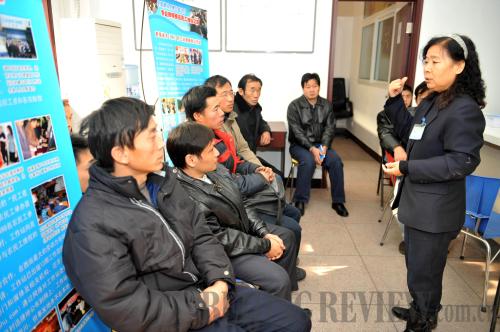|
Labor disputes
 |
|
LAW EDUCATION: A lawyer from the Beijing Zhicheng Migrant Workers Legal Aid and Research Center gives a lecture to workers on how to protect their rights on November 28, 2009 (JIN LIANGKUAI) |
The number of labor disputes soared across China after the implementation of the Labor Contract Law.
The number of labor disputes across China in 1995 reached 30,000. It increased to 310,000 in 2006 and 350,000 in 2007, according to the Ministry of Human Resources and Social Security (MHRSS) statistics. In 2008, the year the new law went into effect, the number soared to 690,000, up by nearly 50 percent over 2007.
The courts at different levels across China mediated more than 280,000 labor dispute cases in 2008, an increase of 94 percent over the previous year, the Supreme People's Court (SPC) reported.
In 2009, the number of labor disputes handled by arbitration bodies appeared to post a small decline but still remained high. Arbitration bodies at different levels handled 519,000 labor disputes in the first three quarters of 2009, down 0.2 percent year on year according to the MHRSS statistics. In the same period, 496,000 cases were concluded, up 14 percent year on year.
At the same time, the number of labor disputes handled by the courts across China exploded. The courts at different levels handled more than 170,000 labor dispute cases in the first half of 2009, a 30 percent year-on-year increase, according to the SPC statistics. In Guangdong, Jiangsu and Zhejiang provinces, the year-on-year increase reached 42 percent, 50 percent and 160 percent, respectively, in the first quarter of 2009.
"The implementation of the Labor Contract Law enhanced workers' awareness of their rights. It is good to see the increase in the number of labor disputes," said Ye Jingyi, a Peking University Law School professor.
Ye said that a multi-party labor dispute system is being formed amid cooperation between labor departments, trade unions and courts. Connections have been formed between Beijing, Tianjin, and Guangdong and Fujian provinces to provide a more timely settlement of labor disputes.
But Ye also said that successful resolutions for workers involved in labor disputes had decreased. "Previously, 80 percent of workers won labor dispute cases, but the proportion has declined to 50 percent in the last two years for many reasons," she said.
Current labor dispute cases have become more complicated than before, she said. In the past, most disputes focused on worker injury compensation and employment remuneration, but many new situations have recently appeared. More cases focus on social insurance, retirement compensation, labor contracts, equal pay for equal work and many other complex situations.
Also, some local authorities take measures to suppress workers' appeals, Ye said. They have established internal regulations and have also made wrong interpretations of the Labor Contract Law.
To remedy the situation, the SPC issued a guideline in July 2009 that requested guarantees to workers' rights while also working for rapid economic development.
Ye said that today's labor disputes have taken on the characteristics of organization, regionalism and collectivity. Mass labor disputes are also increasing.
The biggest obstacle for workers who wish to defend their rights is still that they seldom sign labor contracts. "Most cases involve infringement situations such as wage arrears, a lack of social insurance and refusals to provide work injury compensation. It is difficult for workers to claim rights if they do not sign labor contracts," she said.
Feng Shizheng, a professor at Renmin University of China, said that the Labor Contract Law needs a series of supporting organizations, such as trade unions, to push forward its effectiveness.
"Making more efforts to develop grassroots trade unions is an important way to safeguard workers' legal rights," he said. | 